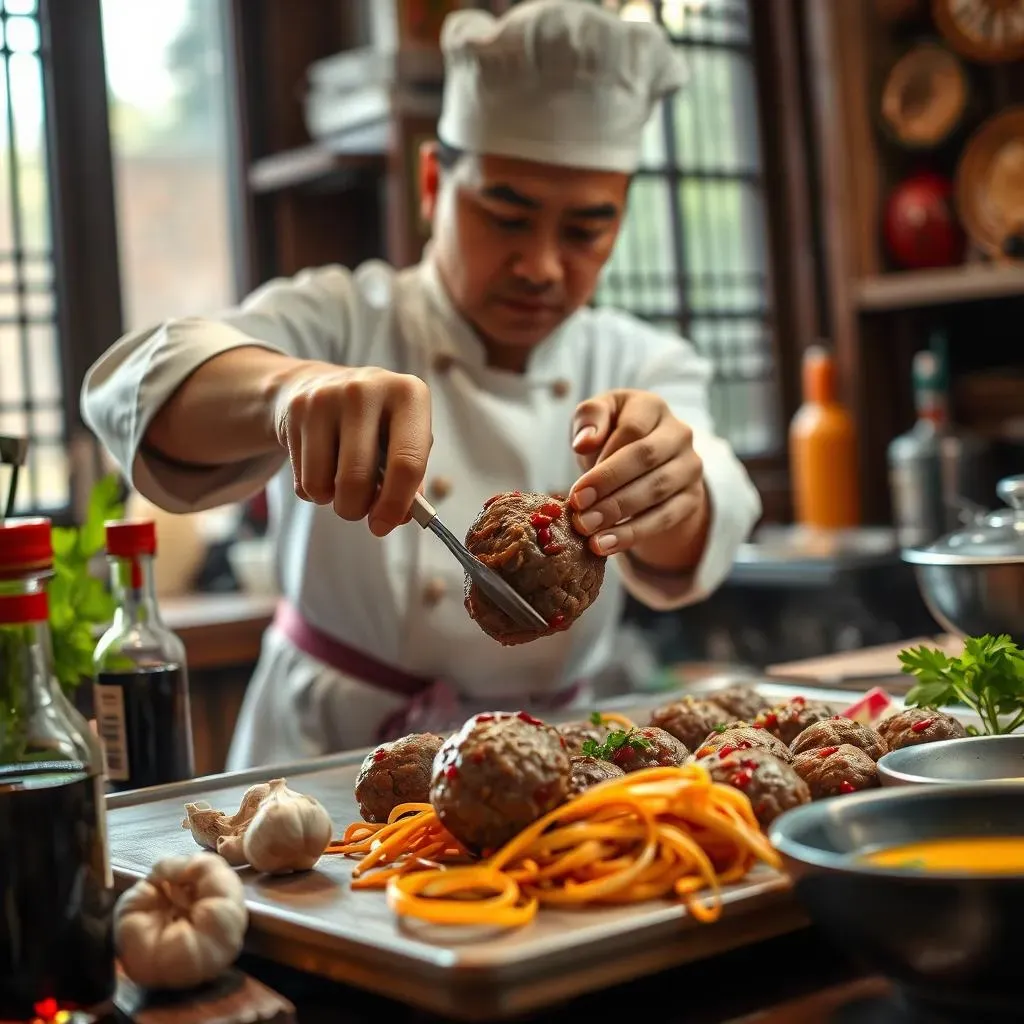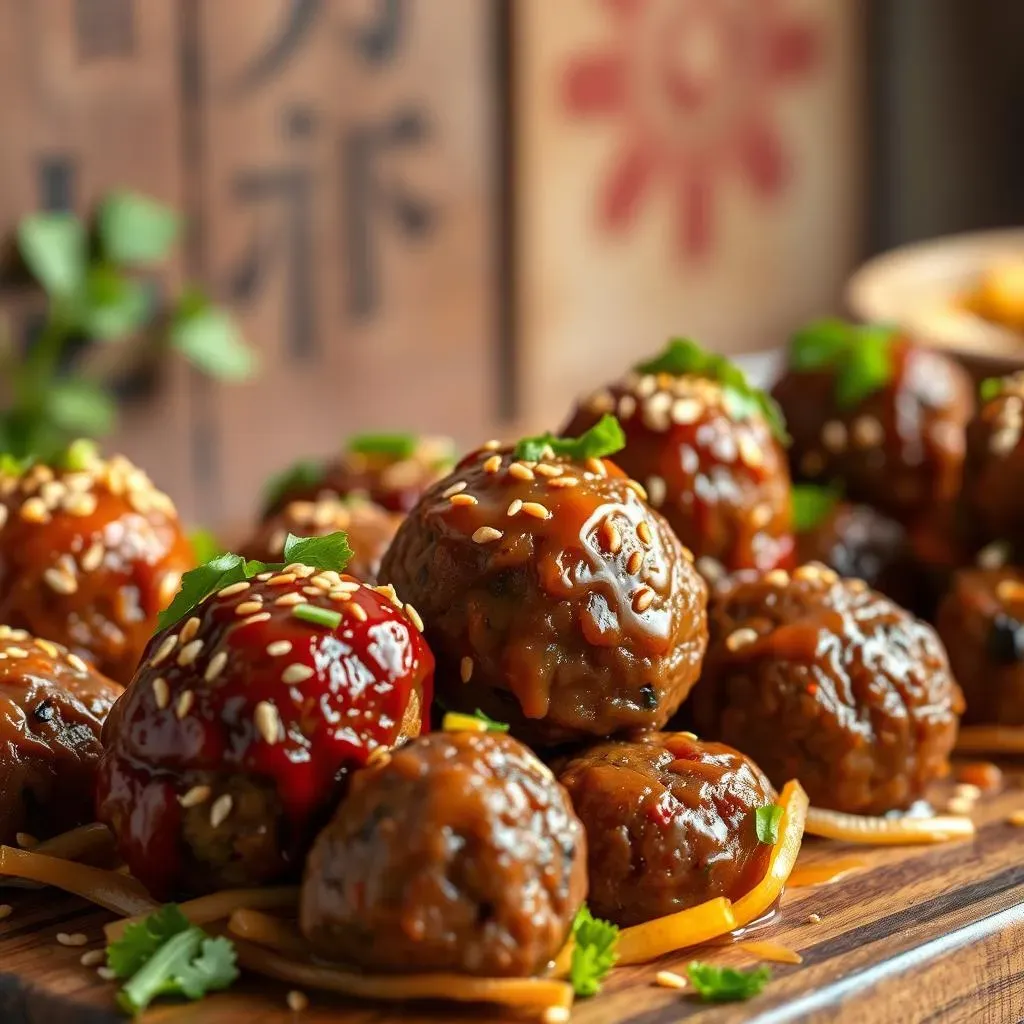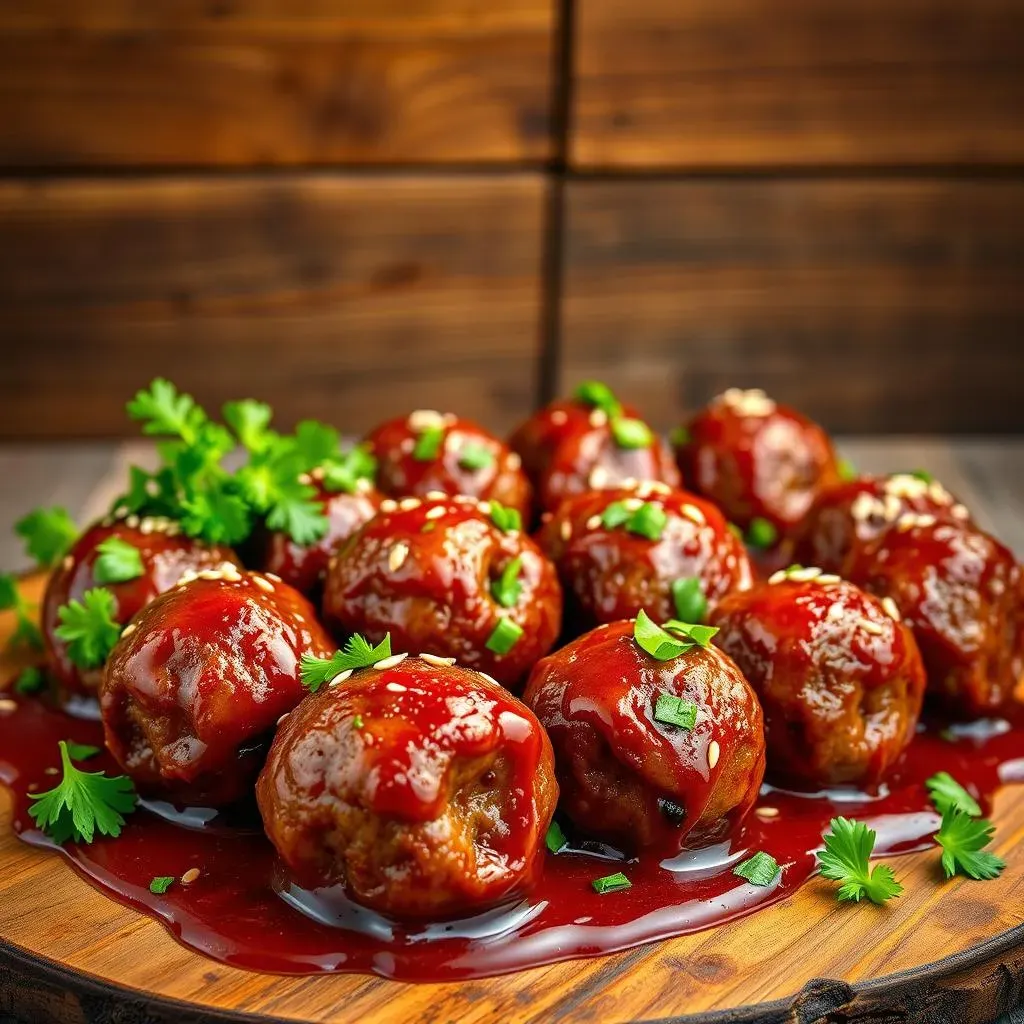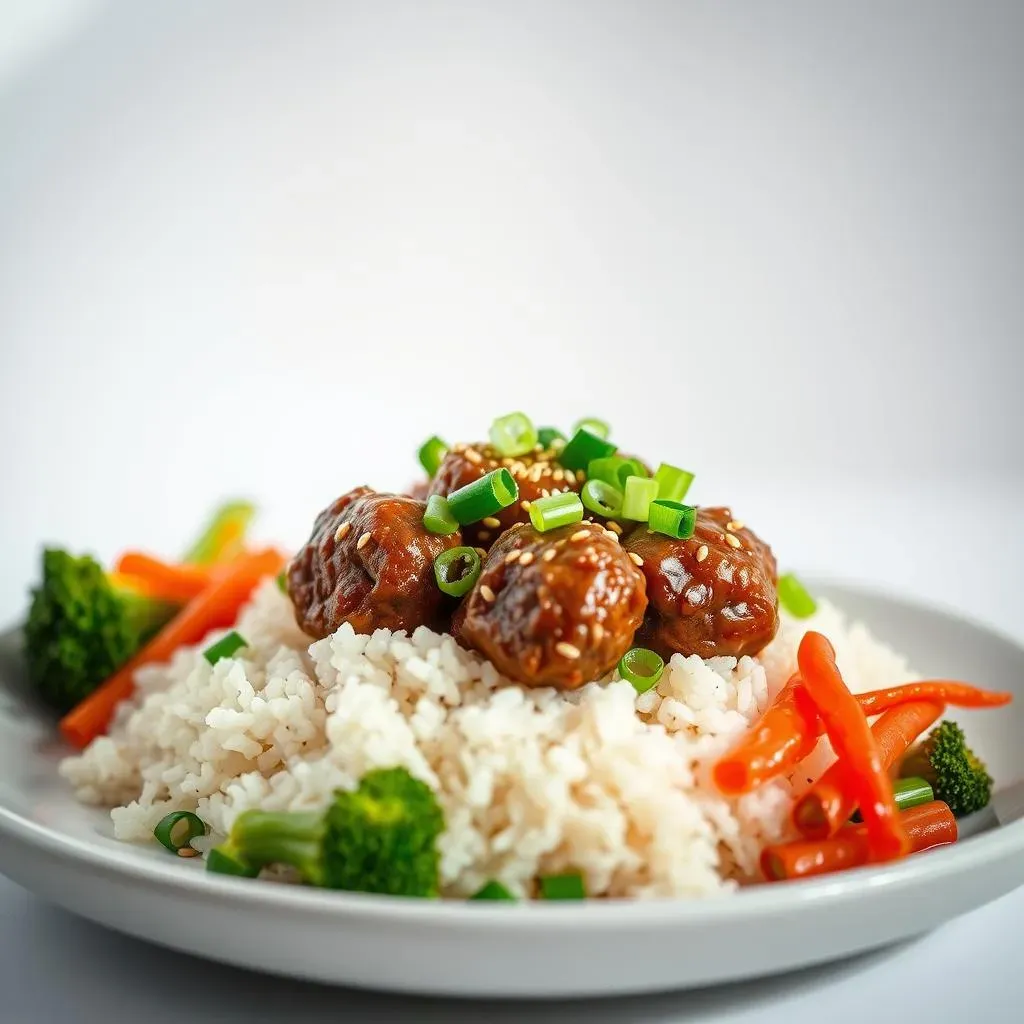Table of Contents
Are you ready to embark on a culinary adventure? This article is your passport to a world of flavor with our exploration of the amazing Asian beef meatball recipe. Forget bland, boring meatballs; we're diving headfirst into a vibrant tapestry of tastes and textures inspired by the rich culinary traditions of Asia. We'll start by mastering the fundamental techniques for creating juicy, perfectly seasoned Asian beef meatballs. Then, get ready to explore the diverse landscape of Asian flavors, from the sweet and savory notes of teriyaki to the fiery kick of sriracha. We'll uncover the secrets to achieving that perfect balance of spice and umami, ensuring your meatballs are unforgettable. Along the way, we'll share expert tips and tricks, helping you avoid common pitfalls and achieve consistently delicious results. Finally, we'll explore creative serving suggestions, transforming your Asian beef meatballs from a simple dish into a culinary masterpiece. Whether you're a seasoned cook or a kitchen novice, prepare to be inspired and amazed by the versatility and deliciousness of the Asian beef meatball recipe. Let's get cooking!
Mastering the Art of Asian Beef Meatballs

Mastering the Art of Asian Beef Meatballs
The Foundation: Choosing Your Ingredients
Let's start with the star of the show: the beef. The quality of your ground beef directly impacts the final flavor and texture of your meatballs. Opt for a blend that's not too lean; an 80/20 or 85/15 ratio generally works best. Too lean, and your meatballs will be dry and tough. Think of it like this: a little fat is your friend, adding juiciness and flavor. Next, consider your aromatics. Fresh ginger and garlic are essential for that authentic Asian flavor profile. Don't skimp on them! Mince them finely for even distribution throughout the meatball mixture. Finally, your choice of soy sauce, fish sauce, or a combination of both will significantly influence the overall savory depth of your meatballs. Experiment to find your favorite balance!
For a truly authentic taste, consider using a combination of soy sauce and fish sauce. Soy sauce provides a salty, umami punch, while fish sauce adds a deeper, more complex savory note. The ratio is entirely up to you; start with equal parts and adjust to your preference. Remember, a little goes a long way! If you're unsure about fish sauce, start with a small amount and gradually increase it until you find the right balance. You can also enhance the flavor profile with other Asian-inspired ingredients such as sesame oil, rice wine vinegar, or even a touch of chili garlic sauce for a spicy kick. For a simpler approach, check out our simple beef meatballs recipe for inspiration.
Ingredient | Role | Tip |
|---|---|---|
Ground Beef | Flavor & Texture Base | Avoid extra-lean for juiciness |
Ginger & Garlic | Aromatic Depth | Mince finely for even distribution |
Soy/Fish Sauce | Savory Umami | Experiment with ratios to find your preference |
The Technique: Mixing and Shaping Your Meatballs
Now that you've gathered your ingredients, it's time to get your hands dirty! Gently combine the ground beef, aromatics, and your chosen sauces. The key here is "gently." Overmixing will develop the gluten in the beef, leading to tough meatballs. Imagine you're making a delicate sculpture, not kneading bread. Use your hands to lightly incorporate the ingredients until just combined; you want a cohesive mixture, not a perfectly uniform one. This is where your intuition comes into play. You'll develop a feel for the right consistency.
Once your mixture is ready, form the meatballs. Aim for uniform size for even cooking. A tablespoon or a small ice cream scoop works great for consistency. Don't pack the meatballs too tightly; this will also result in tough meatballs. Gently roll them into balls, ensuring they hold their shape. A light touch is crucial here, too! If you’re looking for more beef-centric recipes, check out our meatball recipes using ground beef. After forming, you can refrigerate the meatballs for 30 minutes before cooking. This helps them firm up and hold their shape better during cooking.
- Gently combine ingredients
- Avoid overmixing
- Form uniform-sized balls
- Don't pack too tightly
- Refrigerate for 30 minutes (optional)
Exploring Diverse Asian Beef Meatball Flavors

Exploring Diverse Asian Beef Meatball Flavors
Sweet and Savory Sensations: Teriyaki & Honey Glaze
Let's kick things off with a classic: the teriyaki-honey glaze. The combination of sweet honey and savory teriyaki sauce creates a delightful balance that complements the richness of the beef. The glaze adds a beautiful sheen and a sticky, delicious coating to the meatballs. To achieve the perfect teriyaki-honey glaze, start with a good quality teriyaki sauce—look for one with a balanced sweetness and umami. Then, add a touch of honey to enhance the sweetness and create that irresistible sticky texture. You can adjust the honey-to-teriyaki ratio to suit your taste, but a 1:2 ratio is a great starting point. For a more intense flavor, consider adding a touch of grated ginger or garlic to the glaze. Don't forget to toss the cooked meatballs in the glaze for that perfect glossy finish! For another delicious meatball option, try our spicy beef meatballs recipe.
Think of the teriyaki-honey glaze as the perfect marriage of East and West. The savory teriyaki, often found in Japanese cuisine, combines perfectly with the sweetness of honey, a global ingredient. This fusion creates a unique and delectable flavor profile that's both familiar and exciting. To elevate this classic combination, consider adding a pinch of toasted sesame seeds for extra crunch and aromatic depth. The sesame seeds bring an earthy nuttiness that perfectly complements the sweet and savory elements of the glaze. The subtle toastiness enhances the complexity of the dish, adding another layer of sensory experience. For a simpler approach, you can always just use a store-bought teriyaki sauce, but homemade teriyaki always has a special touch!
- Use high-quality teriyaki sauce.
- Adjust honey-to-teriyaki ratio to taste.
- Add ginger or garlic for extra flavor.
- Garnish with toasted sesame seeds for added crunch and aroma.
Spicy and Zesty Adventures: Chili Garlic & Lemongrass
Now, let's turn up the heat with a chili garlic and lemongrass infusion. This combination introduces a vibrant, zesty twist to the traditional meatball. The fragrant lemongrass lends a refreshing citrusy note that cuts through the richness of the beef, while the chili garlic sauce provides a delightful kick of heat. For the best results, use fresh lemongrass—you can find it in most Asian grocery stores. Finely chop the lemongrass and incorporate it into the meatball mixture before shaping. For the chili garlic sauce, choose one that balances heat with flavor. Don't be afraid to experiment with different brands to find your preferred level of spiciness. For a milder heat, you can always reduce the amount of chili garlic sauce used.
Imagine the explosion of flavors in your mouth: the savory beef, the aromatic lemongrass, and the fiery chili garlic sauce. It's a symphony of tastes that will tantalize your taste buds. The lemongrass adds a unique, almost floral fragrance that elevates the entire experience. The chili garlic sauce adds a welcome layer of complexity, making these meatballs both exciting and satisfying. This recipe is perfect for those who love a little heat in their food. To further enhance the flavor profile, consider adding a squeeze of lime juice to the chili garlic sauce for an extra burst of acidity. This will brighten up the sauce and make it even more refreshing. If you're looking for more flavor variations, check out our Italian-style beef meatballs for a different take on this classic dish.
Ingredient | Flavor Profile | Tip |
|---|---|---|
Lemongrass | Citrusy, Refreshing | Use fresh, finely chopped lemongrass. |
Chili Garlic Sauce | Spicy, Savory | Adjust amount to control spiciness. |
Lime Juice (optional) | Bright Acidity | Adds a refreshing zing. |
Tips and Tricks for Perfect Asian Beef Meatballs

Tips and Tricks for Perfect Asian Beef Meatballs
Don't Overwork the Meat
Gentle handling is key! Overmixing your meatball mixture leads to tough meatballs. Think of it like this: you're aiming for a cohesive mixture, not a perfectly smooth paste. Just combine the ingredients until they're evenly distributed. Overmixing develops the gluten in the beef, resulting in a less tender final product. A light touch is your friend here. Too much handling will squeeze out moisture, making your meatballs dry. Remember, you're aiming for juicy, flavorful meatballs, not dense hockey pucks! For more tips on achieving the perfect texture, check out our guide on choosing the best ground beef for your recipe.
Once you've gently combined your ingredients, it's time to shape those meatballs. Use a spoon or a small ice cream scoop to ensure consistent sizing. This helps them cook evenly. Avoid packing the meat too tightly when rolling them into balls; this will also lead to dry, tough meatballs. A slightly loose consistency allows for better moisture retention during cooking. If you're looking for another flavorful option, try our herb-infused beef meatballs recipe for a unique twist.
- Mix gently to avoid tough meatballs.
- Use a spoon or scoop for consistent size.
- Don't pack the meat too tightly.
Cooking to Perfection: Baking, Frying, or Simmering
There are several ways to cook your Asian beef meatballs, each offering unique advantages. Baking is a hands-off method that ensures even cooking and prevents sticking. Simply arrange your meatballs on a baking sheet, ensuring there's space between each one for even heat distribution. Frying offers a delicious crispy exterior while maintaining a juicy interior. Use a neutral oil with a high smoke point, and ensure your meatballs are not overcrowded in the pan. Simmering is a gentle cooking method that’s perfect for creating a rich, flavorful sauce. Submerge the meatballs in your chosen sauce and simmer until they’re cooked through. No matter which method you choose, remember to cook the meatballs until they reach an internal temperature of 160°F (71°C) for food safety.
The cooking time will vary depending on the size of your meatballs and your chosen cooking method. For baking, it's typically around 20-25 minutes in a preheated oven at 375°F (190°C). Frying usually takes around 8-10 minutes, while simmering can take anywhere from 15-20 minutes, depending on the sauce. Use a meat thermometer to ensure they're cooked through. Don't overcook them—overcooked meatballs are dry and tough. For more ideas on cooking techniques, check out our selection of ground beef meatball recipes with diverse cooking methods.
Cooking Method | Pros | Cons |
|---|---|---|
Baking | Even cooking, hands-off | Can be slightly less flavorful |
Frying | Crispy exterior, flavorful | Requires more attention |
Simmering | Rich sauce, tender meatballs | Longer cooking time |
Serving Suggestions for Your Asian Beef Meatball Recipe

Serving Suggestions for Your Asian Beef Meatball Recipe
Over Rice or Noodles: A Classic Combination
The most straightforward, and arguably most satisfying, way to enjoy your Asian beef meatballs is over a bed of fluffy rice or noodles. Steamed white rice provides a neutral canvas that lets the bold flavors of the meatballs shine. Alternatively, try serving them over egg noodles, ramen, or even udon for a heartier meal. The noodles absorb the delicious sauce, creating a flavorful and texturally diverse dish. For a lighter option, consider using zucchini noodles or shirataki noodles for a lower-carb alternative.
Consider adding some vibrant vegetables to your rice or noodle bowl to create a more balanced and visually appealing meal. Stir-fried broccoli, bok choy, or snap peas offer a nice textural contrast to the meatballs. A simple side of steamed edamame adds a touch of elegance and extra protein. Don't be afraid to experiment with different vegetable combinations to find your favorites. Remember, presentation matters! A well-plated meal is always more appealing. For more rice-based recipes, check out our beef meatball spaghetti recipe for inspiration.
Base | Pros | Cons |
|---|---|---|
White Rice | Neutral flavor, widely available | Can be high in carbohydrates |
Noodles | Hearty, diverse options | Can be high in carbohydrates (some options) |
Zucchini Noodles | Low-carb, healthy | Can be less satisfying for some |
Beyond the Bowl: Appetizers and Skewers
Your Asian beef meatballs aren't limited to bowls of rice and noodles! They make fantastic appetizers, perfect for parties or casual gatherings. Serve them on toothpicks or small skewers, drizzled with extra sauce for a flavorful bite-sized treat. Guests will love the convenience and deliciousness of these miniature masterpieces. Consider adding some colorful garnishes, such as chopped green onions or sesame seeds, to elevate the presentation. A simple dipping sauce, such as sweet chili sauce or a soy-ginger mixture, complements the meatballs perfectly.
For a more substantial appetizer, consider serving your meatballs on a bed of greens or in small lettuce cups. This adds a fresh, crunchy element that balances the richness of the meatballs. You can also use these meatballs as part of a larger buffet spread, arranging them alongside other Asian-inspired dishes for a cohesive and impressive meal. The possibilities are endless! If you're looking for more appetizer ideas, check out our easy ground beef meatball recipe for inspiration.
- Serve on toothpicks or skewers for appetizers.
- Add garnishes like green onions or sesame seeds.
- Offer dipping sauces for extra flavor.
- Serve on lettuce cups or with a side salad.
Creative Culinary Adventures: Salads, Wraps, and More!
Let your creativity run wild! Asian beef meatballs can be incorporated into a wide variety of dishes, adding a protein punch and a burst of flavor. Consider adding them to a vibrant Asian-inspired salad, for example. The meatballs add a hearty element to the lighter salad, creating a satisfying and nutritious meal. Alternatively, use them as a filling for lettuce wraps or spring rolls for a fresh and flavorful twist. The possibilities are truly endless!
Think outside the box! Experiment with different flavor combinations and serving styles to create unique and memorable meals. You can even add your meatballs to soups and stews for a heartier dish. Or, if you're feeling adventurous, try making meatball subs with an Asian twist—imagine a flavorful hoisin-based sauce instead of traditional marinara. For more inspiration, explore our collection of ground beef meatball recipes, which showcase the versatility of this classic dish.